Regional Cooperation and Integration in Asia and the Pacific: Responding to the COVID-19 Pandemic and "Building Back Better"Platforms for regional and subregional cooperation helped spur collective action to help Asia and the Pacific build back resiliency from the coronavirus disease (COVID-19) pandemic. Regional cooperation platforms such as the South Asia Subregional Economic Cooperation program helped countries respond to the COVID-19 emergency. In South Asia, partners will have the opportunities to support regional market development through transport corridors, trade facilitation, and cross-border energy trade post-COVID-19. Author: Asian Development Bank Year: 2022 Download Tags: ADB, Bangladesh, COVID-19, Economic Corridor Development, Energy, India, Trade Facilitation, SASEC, ADB RCI 2022 , ADB RCI Reforming Port Processes in India for Logistics EfficiencyResearchers undertook port-process mapping at Jawaharlal Nehru and Vishakhapatnam ports, two key export–import gateways in India, to help identify strategic reform and potential solutions to improve port systems in the country. This brief recommends streamlining and digitizing port logistics and operations in India to help reduce logistics cost and make operations more efficient. Author: Asian Development Bank Year: 2021 Download Tags: ADB, India, Customs, ADB RCI Assam as India's Gateway to ASEANAssam's location in northeast India offers opportunities for enhancing cross-border trade and developing regional economic corridors spanning Bangladesh, Bhutan, India, Nepal, and countries in Southeast Asia. By developing trade and economic corridors, Assam aims to build on its vision of becoming a $75 billion economy by 2025. Author: Asian Development Bank Year: 2021 Download Tags: ASEAN, Bangladesh, Bhutan, India, Nepal, Regional Cooperation, Trade, ADB RCI COVID-19 and Transport in Asia and the Pacific: Guidance NoteThis guidance note outlines the effects of the coronavirus disease pandemic on the transport sector in developing Asia and the Pacific. In India, for example, rail freight traffic in April and May 2020 had decreased by 28% compared with demand in 2019. The publication shares possible measure for a post-pandemic recovery that provides greener and more resilient recovery. The publication also proposes regional cooperation bodies for coordinating cross-border freight and logistics and international air travel. Author: Asian Development Bank Year: 2020 Download Tags: ADB, Regional Cooperation, India, Transport, Logistics, ADB RCI New Approaches to Measuring and Assessing Regional Cooperation and Integration: Workshop HighlightsThis publication presents highlights from the Asian Development Bank (ADB) workshop on regional cooperation and integration on 16 and 17 April 2020. Discussions focused on approaches to measuring RCI and its implications for policy assessment. Mr. Ronald Antonio Butiong, Director, Regional Cooperation and Operations Coordination Division, South Asia Department, ADB, discussed regional integration indicators in South Asia Subregional Economic Cooperation (SASEC) member countries and outlined priorities for enhancing economic growth, improving social inclusion, and tackling poverty. Author: Asian Development Bank Year: 2020 Download Tags: Regional Cooperation, South Asia, SASEC, ADB, ADB RCI Developing Multimodal Logistics Parks in IndiaMultimodal logistics parks (MMLPs) help bring down the cost of logistics and improve logistics performance by providing services in freight aggregation and distribution, multimodal freight transport, integrated storage and warehousing, technology support, and value-added services. This brief from the Asian Development Bank examines the potential of MMLPs to support supply chains in India and discusses the feasibility of MMLPs in Bengaluru and Guwahati. Author: Sabyasachi Mitra, Hoe Yun Jeong, Kavita Iyengar, Bhuwan Bhaskar Agrawal, Shreyans Jain, and Atu Sanganeria Year: 2020 Download Tags: ADB, Bangladesh, India, Logistics, ADB RCI 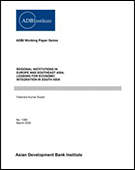 Regional Institutions in Europe and Southeast Asia: Lessons for Economic Integration in South AsiaThis working paper takes a look at the European Union (EU) and the Association of Southeast Asian Nations (ASEAN) as examples of regional institutions that were able to successfully foster economic growth and competitiveness. More specifically, the paper discusses the economic achievements of regional integration within the ASEAN and compares it with the EU. It offers lessons from the ASEAN integration that could help accelerate South Asian regional integration. It also examines the political and economic barriers hindering economic integration in South Asia, and emphasizes potential benefits regional integration and economic cooperation could bring to the South Asian Association for Regional Cooperation (SAARC) region. These include reduced economic dependence on developed countries, increased trade, and stronger economic growth in the SAARC region. Author: Falendra Kumar Sudan Year: 2020 Download Tags: Regional Cooperation, Economic Cooperation, EU, ASEAN, ADB RCI Borders without Barriers: Facilitating Trade in SASEC CountriesBorders without Barriers presents an analysis of the state of trade facilitation in member countries of the South Asia Subregional Economic Cooperation (SASEC) program. The book includes an analysis of the state of trade facilitation in Bangladesh, Bhutan, India, Nepal, and Sri Lanka, as well as in Maldives and Myanmar. It identifies trade facilitation priorities in SASEC countries: implementation of trade facilitation agreements and other conventions; logistics and infrastructure development and regulatory reforms; coordinated border management; and institutions and capacity development. Author: Asian Development Bank Year: 2019 Download Tags: ADB, SASEC, Trade Facilitation Agreement, Bangladesh, Bhutan, India, Maldives, Myanmar, Nepal, Sri Lanka, ADB RCI Maritime Cooperation in SASEC: South Asia Subregional Economic CooperationMost South Asia Subregional Economic Cooperation (SASEC) countries rely on maritime transport for international trade. Stronger maritime relations are crucial to achieve the economic growth potential for the subregion. This report looks at how countries can strengthen international trade by improving maritime cooperation among the SASEC countries, comprised of Bangladesh, Bhutan, India, Maldives, Myanmar, Nepal, and Sri Lanka. It gives an overview of the SASEC maritime sector and identifies collaboration initiatives that could address key challenges. Author: Asian Development Bank Year: 2019 Download Tags: Transport, Trade Facilitation, Bangladesh, Bhutan, India, Maldives, Myanmar, Nepal, Sri Lanka, ADB RCI 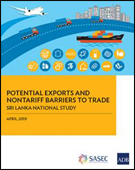 Potential Exports and Nontariff Barriers to Trade: Sri Lanka National StudyHow can Sri Lanka address nontariff barriers (NTBs) that hinder growth of its trade with Bangladesh, Bhutan, India, Maldives, and Nepal? The study examined the impact of sanitary and phytosanitary (SPS) and technical barriers to trade (TBT)-related nontariff measures enforced by SASEC countries to Sri Lanka’s exports with maximum potential, conducted a national diagnostic audit of the SPS and TBT infrastructure, and identified current SPS and TBT infrastructure capacity constraints. It considered options and opportunities to deal with the identified NTBs, including recommendations to improve Sri Lanka’s SPS–TBT infrastructure, and enhancing efficiency of SPS–TBT-related processes. Findings of the study could help formulate policies, laws, and institutions to address SPS–TBT-related NTBs and promote intraregional trade, as well as provide considerations for bilateral Free Trade Agreement negotiations. Additionally, the study provides traders with a comprehensive coverage of available export opportunities in Sri Lanka, and barriers they could encounter. Author: Asian Development Bank Year: 2019 Download Tags: Sri Lanka, Trade, Sanitary and Phytosanitary Measures, Technical Barriers to Trade, Non-Tariff Measures, ADB RCI Investment Climate Improvement in East Coast Economic Corridor of India: Regulatory, Institutional, and Policy Reforms Support to Tamil NaduThis paper summarizes a study that the Asian Development Bank (ADB) undertook upon the request of the Government of Tamil Nadu, India. The state sought to become a preferred investment destination with an investor-friendly business climate. The study identified policy, institutional, and process reforms to improve the ease of doing business in Tamil Nadu, including institutional and regulatory reforms needed for the East Coast Economic Corridor (ECEC) development. The study resulted in the implementation of an online single window mechanism that simplified and sped up processes for transparent and time-bound clearances for investors. Author: Asian Development Bank Year: 2018 Download Tags: ADB, Ease of Doing Business, Economic Corridor Development, India, Single Window, ADB RCI 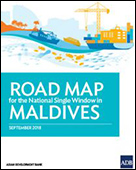 Road Map for the National Single Window in MaldivesThis publication outlines key steps to launching Maldives’ national single window (NSW) platform. An archipelago, Maldives’ geographic dispersion contributes to logistics and border control challenges. An NSW on a digital platform will allow all trade stakeholders to submit and access information on importing and exporting goods in a single place. It will streamline international trade procedures, minimize the time, effort, and resources needed to conduct trade, while helping the government maintain requisite controls. With current bottlenecks to trade in Maldives leading to some of the highest import and export costs in the South Asian subregion, leveraging on information and communications technology will help the country overcome physical and logistical barriers to trade, and significantly improve efficiency. More efficient trade procedures can lower the costs of imports, exports, and goods, and help drive economic growth. Author: Asian Development Bank Year: 2018 Download Tags: Maldives, National Single Window, ADB RCI Risk Management in Maldives: Sharing Practical Experience and Lessons LearnedMaldives is implementing reforms to improve risk management controls and to strengthen its trade environment. Risk management aims to determine which goods need to be examined in detail when entering a country. As government agencies improve service delivery, traders will benefit from reduced time to import and export goods, increased predictability of services, and greater ease of doing business. This report shows that improvements to risk management processes to deliver operational and economic gains in Maldives can be replicated across South Asia. Author: Asian Development Bank Year: 2018 Download Tags: Customs, Maldives, SASEC, Trade, ADB RCI The WEB of Transport Corridors in South AsiaThis book looks at how the economic benefits of investments in transport corridors could be amplified and how negative impacts could be minimized in South Asia. The book introduces an appraisal methodology that looks at the web of interconnected elements around corridors and assesses proposed corridors according to their potential to bring wider economic benefits (WEB). It uses case studies of past and recent corridor initiatives, and presents a simulation of the impact of the proposed Kolkata-Dhaka corridor. Author: Asian Development Bank, JICA, UKAID, World Bank Year: 2018 Download Tags: ADB, Economic Corridor Development, Gender, Regional Integration, Roads, Trade, Transport, WB, ADB RCI Trade Costs, Time, and Supply Chain ReliabilityTrade Costs, Time, and Supply Chain Reliability analyzes the effect of time on trade costs using shipment-level data from the Universal Postal Union. Distance and logistics performance are factors that affect transport times and uncertainty, which increase trade costs substantially. The paper suggests that by investing in improving connectivity, South Asia Subregional Economic Cooperation countries could reduce transport times and increase reliability to major markets. Author: Utsav Kumar, Ben Shepherd, and Roselle Dime Year: 2018 Download Tags: ADB, SASEC, Trade, Transport, ADB RCI Trade Facilitation and Innovation: Evidence from South Asia Subregional Economic Cooperation CountriesThis paper looks at trade and its effects on innovation. Its analysis of firm-level data from Bangladesh, India, and Nepal shows that shorter trade times add competitive pressure from world markets and induces firms to innovate, hence associated with introduction of new products and new management systems. The results suggest that policies that improve trade facilitation would support long-term growth in South Asia Subregional Economic Cooperation countries. Author: Ben Shepherd, Utsav Kumar, and Roselle Dime Year: 2018 Download Tags: Bangladesh, India, Nepal, SASEC, Trade Facilitation Agreement, WTO, ADB RCI Harmonizing Electricity Laws in South AsiaMany in South Asia face electricity shortages that affect their socioeconomic development. But the region has a large hydropower potential and other energy resources that may be harnessed to drive growth in the region. This report looks at legal, regulatory, technical, and commercial requirements for energy trade to advance in the region, and gives recommendations for implementing the South Asian Association for Regional Cooperation Framework Agreement on Energy Trade. Author: Asian Development Bank and the South Asian Association for Regional Cooperation in Law Year: 2017 Download Tags: Bangladesh, Bhutan, Energy, Harmonisation, India, Industrialization, Maldives, Nepal, Regional Cooperation, South Asia, Sri Lanka, Trade, ADB RCI 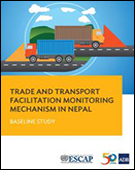 Trade and Transport Facilitation Monitoring Mechanism in NepalThis report synthesizes the business process analysis conducted on import of wool through Kolkata-Birgunj-Kathmandu, export of wool carpet from Kathmandu-Birgunj-Kolkata, and import of fabrics from Bangladesh to Nepal through Dhaka-Banglabandha-Fulbari-Panitanki-Kakarbhitta-Kathmandu. It also measures the performance of trade corridors and border crossings in Nepal, to quantify current trade and transport facilitation and provide recommendations. Findings of the study reveal bottlenecks to trade, including procedures needed to complete import/export, compounded by requirements for transiting trade through India, which further prolongs the trade process and increases the cost. The report includes specific short-term and long-term policies to improve Nepal’s trade and transport facilitation. Author: Asian Development Bank and United Nations Economic and Social Commission for Asia and the Pacific Year: 2017 Download Tags: Trade Facilitation, Nepal, Import, Export, ADB RCI 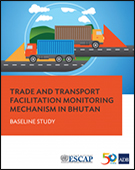 Trade and Transport Facilitation Monitoring Mechanism: Baseline Study in BhutanThis report synthesizes the business process analysis conducted on import of light motor vehicles from third countries to Bhutan via Kolkata Port, import of plastic kitchenware and tableware (melamine products) from Bangladesh to Bhutan, export of ferrosilicon from Bhutan to third countries through Kolkata Port, and export of cardamom from Bhutan to Bangladesh. It also measures the performance of trade corridors and border crossings in Bhutan, to quantify current trade and transport facilitation and provide recommendations. Findings of the study reveal bottlenecks to trade, including numerous procedures needed to complete import/export, and low speed along the trade corridors. The report includes specific short-term and long-term policies to improve Bhutan’s trade and transport facilitation. Author: Asian Development Bank and United Nations Economic and Social Commission for Asia and the Pacific Year: 2017 Download Tags: Bhutan, Trade Facilitation, Bangladesh, ADB, Transport, ADB RCI 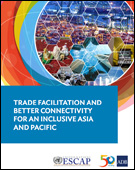 Trade Facilitation and Better Connectivity for an Inclusive Asia and PacificThis report investigates the evolution of trade costs, examines trade facilitation and paperless trade implementation, and highlights key initiatives in South Asia, including efforts by members of the South Asia Subregional Economic Cooperation (SASEC). The SASEC Trade Facilitation and Transport Working Group agreed to expand assistance to trade facilitation through technical assistance to support more efficient, transparent, secure, and service-oriented processing of cross-border trade across South Asia. Through 2025, the SASEC connectivity agenda will be better aligned with the frameworks of South Asian Association for Regional Cooperation and the Bengal Initiative for Multi-Sectoral Technical and Economic Cooperation. To help establish a trade and transport facilitation monitoring mechanism, Bangladesh, Bhutan, and Nepal conducted studies that reviewed trade and transport procedures, analyzed bottlenecks, and gave recommendations on trade and transport facilitation. Author: Asian Development Bank and United Nations Economic and Social Commission for Asia and the Pacific Year: 2017 Download Tags: ADB, Bangladesh, Bhutan, BIMSTEC, Maldives, Nepal, SAARC, India, Myanmar, SASEC, South Asia, Sri Lanka, Trade Facilitation, Transport, UNESCAP, ADB RCI 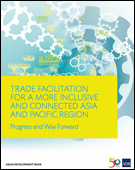 Trade Facilitation for a More Inclusive and Connected Asia and Pacific Region: Progress and Way ForwardThis report gives an overview of assessments from the 2017 global survey on trade facilitation and paperless trade in Asia and the Pacific. It looks at the implementation of trade facilitation and paperless trade measures in 44 countries in Asia and the Pacific, including how the South Asia Subregional Economic Cooperation Trade Facilitation Strategic Framework promotes development by deepening regional cooperation. The Framework covers national and subregional projects in Customs harmonization, improving cross-border facilities, and transport facilitation. The Framework also supports regulatory reforms and the development of the National Single Window Customs management system in Bangladesh, Bhutan, Maldives, and Nepal. Author: Asian Development Bank and United Nations Economic and Social Commission for Asia and the Pacific Year: 2017 Download Tags: ADB, Bangladesh, Bhutan, BIMSTEC, Maldives, Nepal, Regional Cooperation, Regional Integration, SAARC, SASEC, Standards Harmonization, Trade Facilitation, Trade Facilitation Agreement, WTO, UNESCAP, ADB RCI Trade and Transport Facilitation Monitoring Mechanism: Baseline Study in BangladeshThis report synthesizes the business process analysis conducted on the export of plastic kitchenware and tableware from Bangladesh to Bhutan through Burimari land port, and the import of lentils from Nepal to Bangladesh through Banglabandha land port, as well as studies on trade corridors and border crossings in Bangladesh, to quantify current trade and transport facilitation in Bangladesh through a set of indicators. Findings of the study reveal bottlenecks to trade, including costly one-time procedures for a new trader, numerous documents and copies required to complete export and import processes, and low speed along the trade corridors. This report includes specific short-term and long-term policies to improve Bangladesh’s trade and transport facilitation. Author: Asian Development Bank Year: 2017 Download Tags: Trade Facilitation, Transport, Bhutan, Bangladesh, Nepal, SASEC, ADB RCI Lessons from ADB Transport Projects: Moving Goods, Connecting People, and Disseminating KnowledgeThis publication shares 20 case stories from the Asian Development Bank bearing practical lessons for transport projects across Asia and the Pacific region under different socioeconomic and political situations. The book includes reports on improving aviation in Bhutan, working on computerized transport and trade logistics in Nepal, and constructing Sri Lanka's Greenfield Highway, and the role policy plays in those projects. It also draws lessons from how India's road development increased rural communities' access to public services and economic opportunities, and how participatory processes in selecting road improvement projects in Bangladesh provide a model for long-term plan for road maintenance. Author: Asian Development Bank Year: 2017 Download Tags: ADB, Bangladesh, Bhutan, India, Nepal, Railway, Sri Lanka, Transport, ADB RCI SASEC Powering Asia in the 21st Century SASEC Powering Asia in the 21st Century defines the SASEC Vision, framing the SASEC partnership in the larger context of the subregion’s collective growth and development by articulating shared aspirations of the SASEC countries (Bangladesh, Bhutan, India, Maldives, Myanmar, Nepal, and Sri Lanka), and setting the path to achieve these through regional collaboration. The SASEC Vision lays out a subregional transformative opportunity by leveraging natural resources, promoting industry linkages for the development of regional value chains, and expanding the region’s trade and commerce through the development of subregional gateways and hubs. This document is supplemented by SASEC Vision – Myanmar. Author: South Asia Subregional Economic Cooperation Year: 2017 Download Tags: SASEC, Trade Facilitation, Transport, Energy, ADB RCI 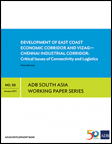 Development of East Coast Economic Corridor and Vizag-Chennai Industrial CorridorThe East Coast Economic Corridor (ECEC)—India’s first coastal corridor—is an integrated economic development initiative that is expected to help pursue industrialization and integrate domestic companies into the global value chains of Southeast Asia and East Asia. Its development will start with Vizag–Chennai Industrial Corridor (VCIC), which covers about 800 kilometers and includes several ports and major industrial centers. This paper discusses strategies to consider when trying to improve shipping and air connectivity in the ECEC and Vizag–Chennai Industrial Corridor (VCIC). It stresses the importance of infrastructure development and regulatory reforms that facilitate increased connectivity. Author: Pritam Banerjee Year: 2017 Download Tags: Bangladesh, Connectivity, Economic Corridor, India, Infrastructure, Regional Integration, Trade Facilitation, Transport, Development, Economic Corridor Development, ADB RCI Connecting Bangladesh: Economic Corridor NetworkEconomic corridors anchored on transport connectivity could significantly boost Bangladesh's economic growth. This paper presents a new set of corridors for Bangladesh – a nine-corridor comprehensive integrated multimodal economic corridor network that will enhance Bangladesh’s role as land bridge between South Asia and Southeast Asia, and between South Asia and northern Asia. These proposed corridors are designed to sustain robust economic growth over the long term by improving regional connectivity, transit, and integration, alongside trade facilitation measures. Author: Mohuiddin Alamgir Year: 2016 Download Tags: Economic Corridor, Bangladesh, South Asia, Southeast Asia, Connectivity, Transport, Trade Facilitation, ADB RCI Improving Energy Efficiency in South AsiaThis paper examines areas where the efficiency of South Asian power systems could be significantly increased, such as the operation of thermal power plants and transmission systems. It also looks at ways to increase conservation by users through time-of-use electricity tariffs, appliance standards, and demand control through smart metering. It concludes that South Asia has a significant potential for energy efficiency improvement in the power sector, which can be realized by implementing policies and programs that can readily complement the existing institutional framework. Author: Priyantha Wijayatunga and Tilak Siyambalapitiya Year: 2016 Download Tags: Energy, ADB, South Asia, ADB RCI 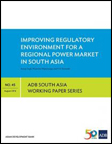 Improving Regulatory Environment for a Regional Power Market in South AsiaCountries in South Asia continue to experience poor access to energy, energy shortages, and concerns for energy security. Bilateral energy trading, with its limited scope, leaves untapped the vast economic, reliability, and environmental benefits of energy cooperation in the region. Improving access to modern energy sources through regional cooperation contributes toward economic growth, and better and more sustainable living conditions in South Asia. Regional energy cooperation supports the development of regional primary energy sources to generate electricity, cross-border transmission infrastructure, and a regional framework that will coordinate energy resource development and trade of electricity across the region. However, this will only be possible with appropriate policies and harmonized legal and regulatory frameworks in all necessary systems. Experience across the world indicates that such legal and regulatory changes can be accomplished successfully. Author: Anoop Singh, Priyantha Wijayatunga, and P. N. Fernando Year: 2016 Download Tags: Energy, Regional Cooperation, South Asia, ADB RCI 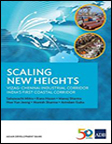 Scaling New Heights: Vizag-Chennai Industrial Corridor, India’s First Coastal CorridorThis book provides policymakers with a guide to understanding India’s economic corridor development strategy by examining its first coastal economic corridor, the East Coast Economic Corridor. It lays out the plan for its first phase, the Vizag–Chennai Industrial Corridor, which can help unify the country's domestic market, integrate its economy with Asia's global value chains, and support the 'Make in India' initiative to spur manufacturing through construction of world-class infrastructure supported by a major transport network, connecting urban clusters complemented by vibrant industrial zones, and encouraging a favorable and competitive environment for businesses to thrive, and facilitating efficient movement of goods and people. As a policy instrument and development strategy, economic corridors can help fast-track inclusive and sustainable economic growth, stimulate rapid industrialization and increase productivity, promote investments, and expand regional connectivity. Author: Sabyasachi Mitra, Rana Hasan, Manoj Sharma, Hoe Yun Jeong, Manish Sharma, and Arindam Guha Year: 2016 Download Tags: Economic Corridor, India, Trade Facilitation, Transport, Employment, Economic Corridor Development, ADB RCI 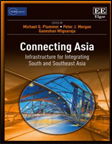 Connecting Asia: Infrastructure for Integrating South and Southeast AsiaThis book contains background papers prepared for the Asian Development Bank and the Asian Development Bank Institute joint study, 'Connecting South Asia and Southeast Asia.' It emphasizes the potential contribution to growth that greater connectivity—through better transport and energy infrastructure and improved soft infrastructure, including trade facilitation—between South Asia and Southeast Asia can foster. With benefits including greater participation in global supply chains for South Asia; lower trade costs; and increase in inter- and intraregional trade, the book underscores that, at a juncture where closer regional integration can secure sustainable and inclusive growth for economies in the two regions, specific policies should be examined and considered to enable both regions to maximize gains from greater integration. Author: Michael G. Plummer, Peter J. Morgan, Ganeshan Wignaraja, eds. Year: 2016 Download Tags: South Asia, Southeast Asia, Trade Facilitation, Transport, Energy, ADB, Economic Corridor, Bangladesh, India, Sri Lanka, ADB RCI Regional Transport Infrastructure: Mapping Projects to Bridge South Asia and Southeast AsiaThis Asian Development Bank (ADB) brief highlights the critical role of transport infrastructure in bridging South Asia and Southeast Asia. It maps details of economic corridors and highways, railroads, and seaports, and identifies priority transport investment projects needed to link the two subregions. While an investment of $986 million in road transport and $2.3 billion in sea ports may be needed to create proper connectivity between the two regions, the study's conservative estimate of potential benefit ranges from $89 billion to $358 billion over the next decade - demonstrating how investment in infrastructure can pay huge dividends in the medium- and longterm. Author: Peter Morgan, Mike Plummer, and Ganeshan Wignaraja Year: 2015 Download Tags: Transport, South Asia, Southeast Asia, ADB RCI Cross-Border Power Trading in South Asia: A Techno Economic RationaleSouth Asian countries have a wealth of diverse energy sources. These renewable resources, along with the varying electricity demand patterns among countries in South Asia, open up opportunities to share resources through electricity trading, which can be enabled by strengthening the electricity transmission system. This study examines the cost and benefit of six cross-border electricity transmission interconnections, and measures the economic and reliability benefits for participating countries in South Asia. Author: Priyantha Wijayatunga, D. Chattopadhyay and P. N. Fernando Year: 2015 Download Tags: Energy, SAARC, Regional Trade, ADB, ADB RCI Lessons for South Asia from the Industrial Cluster Development Experience of the Republic of KoreaGrowth of manufacturing is crucial for economic growth and poverty reduction. This report highlights the industrial cluster development policy of the Republic of Korea, including its success factors in terms of policy implementation, and the promotion of industrial cluster development, drawing lessons that could enhance industrial growth in South Asia. It discusses how the government encouraged increase in exports through relevant policies and adapted to more technology- and knowledge-intensive industries which required innovation-driven policies. The experience outlined in the report could benefit large-scale industrial promotion in South Asia, such as the Economic Corridor Program in India. Author: Jong-il Kim Year: 2015 Download Tags: South Asia, Industrialization, Economic Corridor, Trade, ADB, India, Bangladesh, Sri Lanka, ADB RCI 25 Years on the Ground: ADB-Nepal Partnership for Inclusive DevelopmentThis publication commemorates 25 years of Nepal Resident Mission’s opening and provides an overview of the Asian Development Bank’s (ADB) operation in Nepal over the years. It highlights ADB-assisted projects and Nepal’s association with the South Asia Subregional Economic Cooperation (SASEC) initiative, to further enhance the nation’s role in regional and world trade. These projects aim for regional energy cooperation (SASEC Power System Expansion Project), as well as subregional cooperation and connectivity in the transport sector (SASEC Road Connectivity Project and Subregional Transport Facilitation Project). Author: Asian Development Bank Year: 2015 Download Tags: Nepal, Transport, Energy, ADB RCI Electricity Consumption, Output, and Trade in BhutanThis ADB South Asia Working Paper examines the relationship between electricity consumption, international trade, and economic growth using an augmented production function framework. The findings show that Bhutan is energy-dependent and can promote economic growth through future investment in hydropower. More specifically, the results show that a 1% increase in (i) electricity consumption generates 0.03%-0.05% increase in output, (ii) total trade results in 0.5% increase in output, (iii) trade openness results in 1% increase in output. Author: Hooi Hooi Lean and Russell Smyth Year: 2015 Download Tags: Energy, Trade, Bhutan, ADB, South Asia, Hydropower, ADB RCI 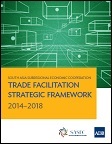 SASEC Trade Facilitation Strategic Framework 2014-2018The South Asia Subregional Economic Cooperation (SASEC) Trade Facilitation Strategic Framework 2014-2018 builds on the momentum of member countries over recent years in forging ahead with many significant improvements to facilitate, and ultimately increase, trade in the subregion and with the rest of the world. It supports the mission of the SASEC Transport and Trade Facilitation Strategy “to promote the prosperity of the subregion by facilitating the efficient movement of trade across the borders”, and focuses on five priority areas: customs modernization and harmonization; standards and conformity assessment strengthening; cross-border facilities improvement; through-transport facilitation; and institution and capacity building. Author: Asian Development Bank Year: 2014 Download Tags: SASEC, Trade Facilitation, Regional Cooperation, Transport, Trade, Customs, Standards, Harmonisation, Regional Integration, ADB, Bangladesh, Bhutan, India, Maldives, Nepal, Sri Lanka, South Asia, ADB RCI Green Power for Bhutan: Clean Energy Crosses Borders to Reach Poor HouseholdsConstructed under the ADB-financed Green Power Development Project, Bhutan's Dagachhu hydropower plant showcases how a public–private partnership for hydropower development successfully promotes cross-border energy trade, contributes to increased national energy security, and improves access to on- and off-grid energy for 9,000 rural households and public facilities. This report reviews the project's key features and discusses how an investment in renewable energy infrastructure is leading Bhutan and its neighboring countries toward greater inclusive growth. Author: Asian Development Bank Year: 2014 Download Tags: Energy, Infrastructure, Poverty Reduction, Bhutan, ADB RCI |



